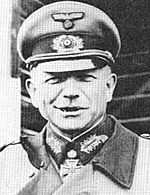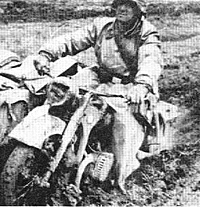
General Guderian moved through the area of Glukhov and rapidly sped through the gap in Russian front, and his XXIV Panzer Corps drove 90 miles in two days to capture Orel.
Guderian image from: German Army 1933-1945.
At almost the same time, XLVII Panzer Corps raced north-west and attacked Bryansk from the rear. In front of the Bryansk defenses, the German 2nd Army had already broken through Russian positions at Desna, making it possible for the XLVII Panzer Corps to link with the 2nd Army and close the ring around the Russians.
German 4th Panzer Group and the 4th Army concentrated near Roslav and attacked General Konev's left wing producing a gap in the front followed by a rapid break through. The next day General Hoeppner's Fourth Panzer Army tore through Russian defences around Vyazma. On 7th October, his XL Motorised Corps, under General Stumme, entered Vyazma and linked up with LVI Panzer Corps, which was under the command of General Schaal.
The left wing of Army Group "Centre" consisting of the German 3rd Panzer Army and the 9th Army moved from north of Smolensk and smashed through Russian right wing. General Hermann Hoth's Third Panzer Army cut round through Kholm and reached Vyazma.
The Russians were encircled and together the Vyazma and Bryansk pockets yielded 663,000 prisoners from 67 infantry divisions, some armoured units and six cavalry divisions plus 1,242 tanks and 5,412 guns. Moscow's primary defensive shield was lost and the road to the capital seemed open.
General Konev was blamed for the disaster and demoted. General Georgi Zhukov was made the new commander of the new West Front (Army Group). On October 14, General Hoth crossed the Volga at Kalinin, cutting the Moscow-Leningrad railway. His Third Panzer Army established itself just 70 miles north of Moscow. Panic swept through Moscow and many government officials fled the city.
By the end of October, Guderian's 2nd Panzer Army was rapidly approaching the industrial city of Tula, 120 miles south of Moscow, ready to capture Moscow from the rear.
As the German forces advanced rapidly, Russian resistance became more and more stubborn. For example, on October 10th at Borodino, the German faced a strong combination of tanks, rockets and well-equipped Siberian troops. The fighting was furious. Men of the 10th Panzer and 2nd SS Panzer Divisions fought hand to hand with spades and rifle-butts against the stubborn Russian defenders.
After much hard fighting, the Germans opened the way toward the second Russian defensive line that ran through Mozhaisk. By the end of October, the German Army had pierced through the Mozhaisk Line and the way to Moscow seemed open.
 General Mud
General Mud
Then came Russia's powerful ally: the weather. In the last week of October heavy raining and sleet started to pour. Roads became full of mud. Supply rate dropped and trucks by the thousand stuck and stalled for want of fuel. The situation in the Russian camp was quite alarming. General Zhukov had only 382 tanks to protect Moscow, of which only half were in working order.
Image from: German Army 1933-1945.
At Tula, however, his 4th Armoured Brigade had 45 wide-tracked T-34's that could travel easily over harsh terrain. It's 76.2 mm ( 3 in ) guns could destroy a German Panzer with a single shot. It was essential on Zhukov's part to stall the Germans until his ally, the 'General Winter' arrived. He knew quite well that the Germans had over extended themselves and were not prepared to fight a winter war.
Zhukov's men fought with great courage trying to hold the Germans. General Guderian's attack on Tula, which was well defended by 45 T-34 tanks and lines of anti-tank ditches, soon bogged down in bitter house to house fighting.
The German Army got there last chance to get moving and capture Moscow on the night of 6/7 November. On that night, the first frosts hardened the ground making it possible for panzers to once again get moving. So on November 15th, the German Army embarked on their final move and attack towards Moscow. The German advance was rapid and one by one Russian villages fell.
By November 28th, the German Army was only 20 miles from the Kremlin. German Generals could see buildings in Moscow's Centre through their field-glasses.
General Winter
But then the 'General Winter' with all its fury struck. The temperatures fell to -40 degrees Centigrade ( -40 degrees Farenheit ). The German army was not prepared for this. They did not have the equipment to survive, let alone fight.
For example, the 3rd Panzer Army was provided a single overcoat per tank crew in their first shipment. Machine guns froze, oil turned to sludge, batteries died and engines had to be kept running most of the time, draining fuel supplies drastically.
On December 1st, Kluge launched a final attack along the Minsk-Moscow highway. Because of the harsh weather, the attack was called off on December 5th. On December 2nd, 1941, motorcyclists of the 62nd Panzer Engineer Battalion, moved forward and entered Khimki which is 5 miles from Moscow and 15 miles from the Kremlin. After riding round the town and terrifying the locals, the motorcyclists returned back to their base. That is as far as the Germans got to Moscow.
More Operation Typhoon: Battle of Moscow
Back to Table of Contents -- World War Two Newsletter May 2002
Back to World War Two Newsletter List of Issues
Back to MagWeb Magazine List
© Copyright 2002 by Shahram Khan.
This article appears in MagWeb (Magazine Web) on the Internet World Wide Web.
Other military history articles and gaming articles are available at http://www.magweb.com